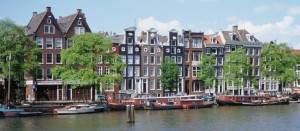It can be difficult to find new angles through which to view places you already know well. Human nature being what is, it takes a conscious effort to see anything through new eyes. We tend to see only what we’re familiar with, and what strikes our vision on the most surface levels: the old buildings, the people, the streets, the here-and-now bustle that is so easy to get caught up in. But shifting our approach is sometimes needed if we are to really appreciate all the layers and the richness any place has to offer.
As a travel writer I’m always forced to do this, and though it’s challenging, it always rewards me with a much deeper perspective of a city’s beating heart and long-hidden scars.
For example, trying to find a topic in which to write about can suddenly have me thinking thematically. In the case of Amsterdam, I was recently casting about for a theme. The picturesque canals and predictable clichés are worn out. I wanted to go deeper.

Go deeper; don’t settle for the surface.
Of course, a well-deserved reputation for religious tolerance in previously intolerant times is a strong undercurrent in the city’s history, shaping its character. But everyone knows about the city’s lenient attitude towards marijuana and prostitution. The pot-selling “coffeshops” and the brightly painted brothels of the Red Light District are hard to miss, and at any rate weed and sex are not exactly major taboos anymore. So, in doing this “personality profile”, as I like to view travel writing, I decided to focus on the less well-known, more hidden-in-plain-sight landmarks that quietly but effectively tell the story of Amsterdam’s legacy of tolerance in intolerant times.
The point is, looking around the city for these things forced me to look through fresh eyes. I began to notice things I hadn’t paid much attention to before. Statues and plaques commemorating Amsterdam’s history—normally easy to pass over in the bustling, thoroughly modern city—began to emerge from the background, as if reaching out through the centuries to educate me with a silent power.
Paying attention to these small reminders eventually told a story, a long and rich narrative, of how the city’s philosophy of tolerance became a beacon for many persecuted people seeking a safe refuge from their own country’s intolerance in a way that the pot bars and sex shops could not. Small churches emerged from the urban crush and hordes of camera-toting tourists, inviting me into their quiet, solemn interior just as they’d invited minority sects whose beliefs had marked them out for discrimination. Small Catholic churches in times of Protestant intolerance (and vice versa) thrived here, as did humble little synagogues that operated without interference or malice from the city’s fathers.
Around a corner from a busy street, a small brick building in a quiet courtyard bears a faded plaque indicating that English pilgrims came here to worship before heading to the New World. They prayed here, and then boarded the Mayflower to escape persecution in their home country. They were made to feel comfortable here.
The remnants of more recent times came to the fore as well. I begin to notice the many houses bearing historical plaques indicating that the occupants courageously sheltered Jewish families during the Second Word War.
Not far away a statue of a portly, none-too-attractive dockworker seems at first glance to be a forgettable, bland post-war tribute to laborers. Look closer and you’ll find an inscription indicating that it memorializes the brave stand of the Amsterdam’s dockworkers, who staged the first strike undertaken in Occupied Europe to protest the mistreatment of the city’s Jews by the Nazis.
The strike, held a few days after 400 Jewish men were herded together on the spot where the statue now stands, was brutally put down by the SS within hours, and is remembered by few today. The statue’s rotund subject was a real-life non-Jewish dockworker who participated in the strike because he felt it was the right thing to do.

The Dockworker statue commemorating the Strike of 1941
A small room in the city’s historic Dutch Theatre, once a point of assembly for Jews about to be shipped off to concentration camps, holds a humble memorial of three little stones. The memorial seems unimportant. Search for the true story, however, and you’ll find that the three stones represent a local man named Walter Suskind, his wife and small daughter. Suskind was the hero who smuggled 1,200 Jewish children to safety during the war. In 1945 his activities were discovered by the Nazis and he and his family were themselves sent to Auschwitz, never to return.
Soon I begin to understand how many centuries’ worth of brave Amsterdammers have risked it all to welcome and aid minorities in dark times, and that courage was common place in the face of tyranny. It underscores the strength of Amsterdam’s heritage of tolerance more than any fashionable pot bar or cheesy sex shop ever could.
My point is, the “what” that you look for isn’t nearly as important as the act of searching for new ways to connect to a city’s unique DNA. The important thing is looking from a thematic perspective, searching for that thread of history that informs its culture. This can provide the prism through which you can see through the here-and-now veneer and access the richness of a city’s historical character, forged in the crucible of time and trial.


